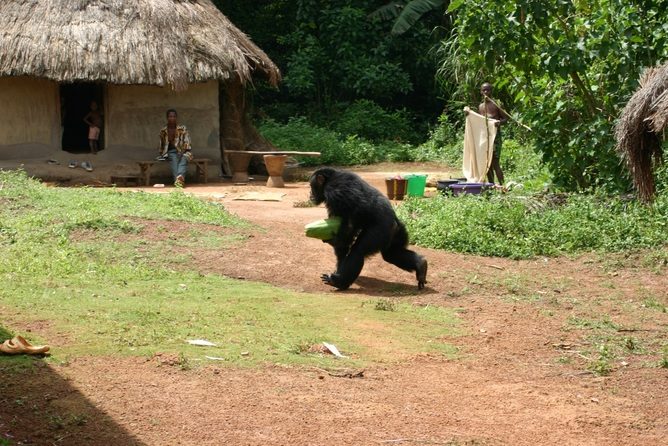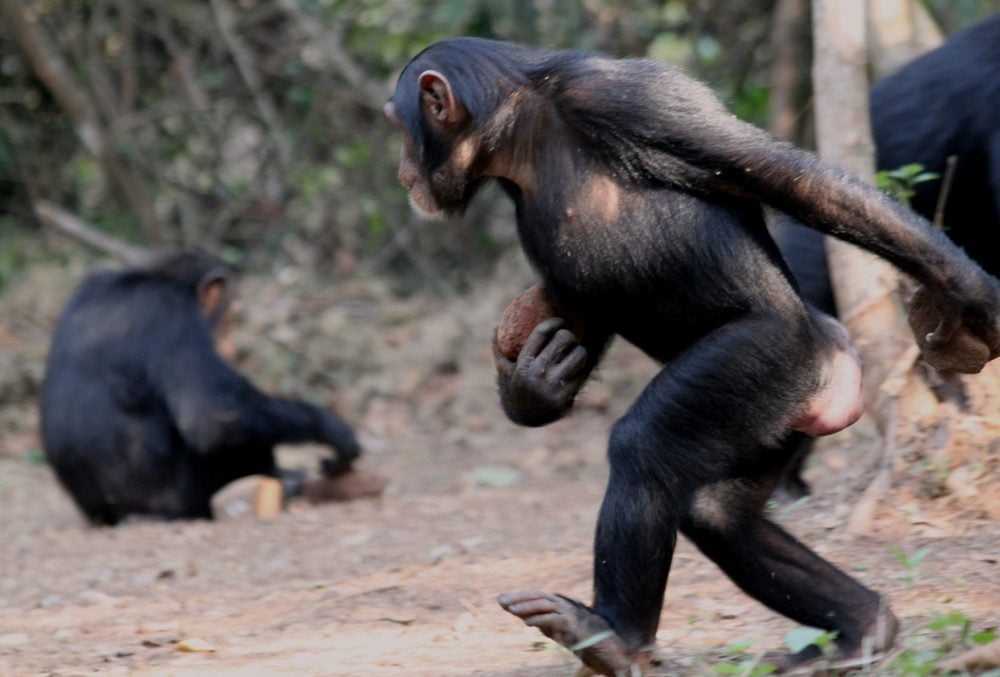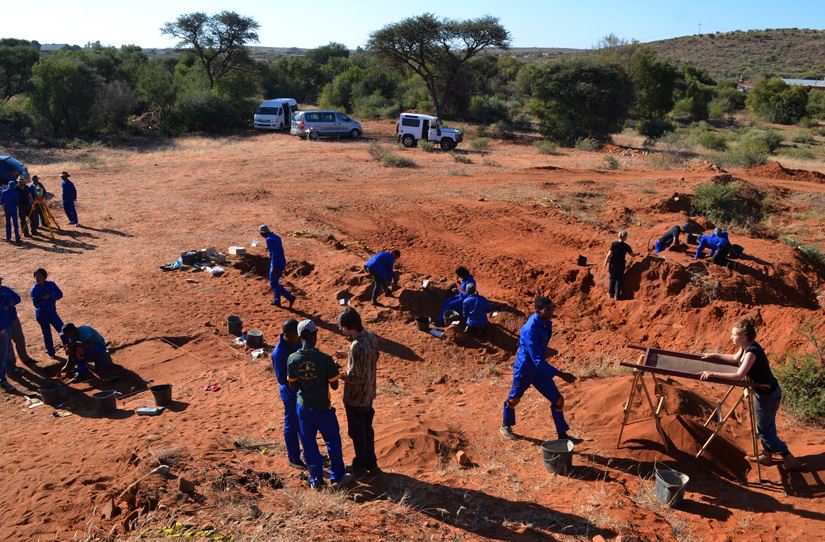Guest Post
By Susana Carvalho, George Washington University
 Chimpanzees are wily enough to adapt in some ways when people encroach on their turf. Kimberley Hockings, CC BY-NC-ND
Chimpanzees are wily enough to adapt in some ways when people encroach on their turf. Kimberley Hockings, CC BY-NC-ND
In the mid 20th century, when paleoanthropologist Louis Leakey sent three pioneering women to study great apes in their natural habitats, the Earth’s wilderness was still untouched in many places. Jane Goodall went to Gombe in Tanzania to study chimpanzees; at first she could only study them with binoculars from far away because the chimps would not let her approach. In those days, Gombe was not the tiny island of forest surrounded by villages and crop fields it is today. In the neighboring country of Rwanda, Dian Fossey became the first researcher to be accepted by wild mountain gorillas. In the 1960s, her “gorillas in the mist” had not yet suffered the severe impact of war and refugees. The third of Leakey’s Angels Birutė Galdikas, arrived in Borneo to study the red apes, orangutans. When she started her work in 1971, oil-palm plantations and loggers were just beginning to force orangutans into increasingly small patches of rain forest.
 A baby mountain gorilla born today has never known a pristine environment free of threat from people. Bradford Duplisea CC BY-NC-ND
A baby mountain gorilla born today has never known a pristine environment free of threat from people. Bradford Duplisea CC BY-NC-ND
When these pioneering women started studying great apes in their pristine forests, the Earth had just entered a time characterized by the tremendous impact of humans on every ecosystem of our planet, what many scientists call a new epoch: the Anthropocene. Hunting, poaching and logging was taking place in the 1960s and 1970s, but the scale of the problem has dramatically increased since then.
As researchers studying great apes in the wild, we’re fully aware that there are few, if any, untouched forests left in tropical Africa and Southeast Asia. Chimpanzee sites across equatorial Africa are suffering human disturbance, but little is known about the ways in which these apes are surviving alongside their human neighbors. The unfortunate situation of declining habitat provides an interesting opportunity for science: we can study these apes in novel situations they’ve never had to deal with before and we can look for clues about our own evolutionary past.
Responding to new pressures
Is the behavior of our closest evolutionary cousins changing as human settlements and roads push into their habitats? We’ve observed that the chimpanzees of Bossou (Guinea), a field site under severe human pressure, increase their waiting time when they have to cross a large road with heavy human and vehicle traffic and wait less time before crossing a narrow, quieter road. Adult male chimpanzees are more likely to lead and bring up the rear when crossing the larger, more dangerous road with a group, in an attempt to protect vulnerable individuals in the road-crossing party, such as infants.
Apes now also need to cope with increased competition from human beings for resources such as fruits. Chimpanzees are developing new strategies to access resources that are shared with people. Adult males are more likely to take the risk to enter the village to raid human crops than females and younger individuals are; sometimes they bring these crops back to the safety of the forest to share with females. Researchers in Uganda have recorded nocturnal crop-raiding by chimpanzees. Typically, they haven’t previously been observed in activities after dark and this suggests that they are aware that the risks are lower under the cover of darkness.
 Chimpanzee in Bossou demonstrates how to carry nuts and stone tools with just two feet on the ground. Jules Dore CC BY-NC-ND
Chimpanzee in Bossou demonstrates how to carry nuts and stone tools with just two feet on the ground. Jules Dore CC BY-NC-ND
Novel situations appear to trigger novel behaviors on the part of great apes. For example, we’ve recently reported how chimpanzees in Bossou exhibit bipedal behavior when they need to transport unpredictable and valuable resources, including fruits. Normally chimpanzees move around on four legs. When chimpanzees go to a village to crop-raid papayas, it’s a risky behavior since frequently the fruits grow very close to people’s houses. To minimize their exposure, chimpanzees try to carry as much as possible at once, sometimes as many as three large papayas. By running on two feet, they can carry more of a resource that might not even be available next time they return.
When apes are confronted with new human-induced challenges, we’re able to study the flexibility of ape cognition. Can they figure out how to solve problems they would never encounter if people weren’t a part of their lives? Bossou chimpanzees, for example, have been seen deactivating snares that hunters place in the forest to catch animals that will be eaten as bush meat. They’ve figured out how to free themselves from these traps, and even more amazingly it appears that they transmit the knowledge throughout their group. It’s a surprising and intelligent way of solving the problem, and something researchers haven’t observed in many other animals.<
 Villagers in Bossou watch chimps carrying out a papaya raid mission. Susan Carvalho CC BY-NC-ND
Villagers in Bossou watch chimps carrying out a papaya raid mission. Susan Carvalho CC BY-NC-ND
Different apes living side by side
The study of how these apes face new challenges may also teach us about our own evolutionary past. Researchers René Bobe and Bernard Wood, at George Washington University’s Center for the Advanced Study of Human Paleobiology, are focused on understanding living primates and ancient human fossils to learn about our origins and evolution. They work closely with us and our colleagues studying ape responses to modern-day threats to learn about our own evolution.
For example, how do modern ape species living in the same habitats at the same time interact with one another? During the course of our evolution over many millennia, we know that human ancestors faced severe climatic and environmental changes. Some species survived and continued to evolve. Others went extinct. At various times human ancestors and close evolutionary cousins shared the same environments, much like chimpanzees and gorillas do today in parts of Africa. But we know little about how some of these ancient species competed for space and resources.
Our own species survived these challenges to become the only ape able to colonize the entire planet, and to have in its hands the survival of all other remaining apes. By looking at how great apes coexist now, we might find clues into our own evolutionary past. For instance, the chimpanzees who choose to run on two feet when rushing back to the forest with village crops hint at which pressures may have contributed to our ancestors becoming bipedal.
Human beings and chimpanzees currently share the same habitats, as do human beings and orangutans. Studies of modern sympatric apes – that is, different ape species that live in the same area and encounter one another frequently – can help us answer crucial evolutionary questions: which apes can adapt to rapid environmental change? What characteristics help them do that? How do apes avoid conflict when they must share resources with other apes?
Researchers are interested in whether a more or less specialized diet could be a barrier for adapting to a changing habitat. We also wonder about how apes avoid conflict when facing the need to share resources with other apes. One study in Congo reported interesting cases of chimpanzees and gorillas eating in the same tree at the same time. What is their way of avoiding conflict and sharing resources and space? They feed at different heights of the tree and eat different parts of the plants!
 Eating and sharing papaya after crop raiding. Susana Carvalho CC BY-NC-ND
Eating and sharing papaya after crop raiding. Susana Carvalho CC BY-NC-ND
Apes’ ability to adapt doesn’t mean they should have to
The problem of apes adapting to human-dominated ecosystems has to be approached carefully. We dedicate our lives to trying to save these fascinating animals, and the last thing we want is to misuse the ability of apes to survive as a justification to continue the destruction of their remaining habitats. Some might argue that if wildlife can survive in highly human-influenced areas, then why put so much effort into conservation?
However, for apes to survive this new epoch, the Anthropocene, we need to understand how apes modify their behavior under human impact. We need to understand the limits of ape adaptability. Apes cannot adapt to urban areas, unlike some monkeys such as baboons and macaques. They do not survive in cities and towns. It’s imperative to understand the limits beyond which they cannot survive.
Susana Carvalho is a Postdoctoral Scientist in Human Paleobiology at George Washington University.
This article was originally published on The Conversation.
Read the original article.


